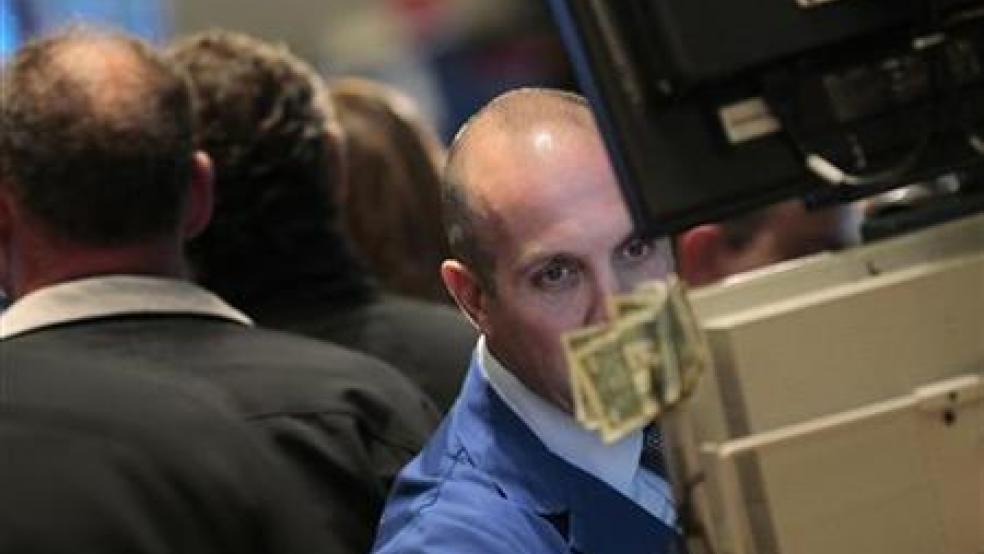LONDON (Reuters) - Spanish and Italian borrowing rates nudged higher on Friday after a two-notch downgrade of Spain's sovereign credit rating, but world equity and currency markets shrugged off the move and Italy managed to sell almost 6 billion euros of new bonds.
Spain's 10-year borrowing rate briefly topped 6 percent again in early trade after Standard & Poor's ratings firm late on Thursday cut the country's credit rating to BBB plus on concern about the government's exposure to its ailing banks.
But yields slipped backed later to trade just 6 basis points higher on the day at 5.95 percent. Italian yields were also slightly higher, but nerves were eased as it sold 5.95 billion euros ($7.87 billion) of new bonds without incident even though at higher rates.
Italy's debt sale "looks better than the market expected because there were quite a few negative comments coming after the Spanish downgrade", said Achilleas Georgolopouos, strategist at Lloyds Bank in London.
"The 5.9 (billion euros) number is pleasing. Any number below five would have created a bit of a problem for them."
Michael Leister, DZ Bank strategist in Frankfurt, said the Italian bond auction meant that there was "at least no further bad news, nothing to provide further fuel to the sell-off we have had in periphery paper this morning".
The limited fallout from the Spanish downgrade elsewhere on world markets shows how much the now chronic euro government debt problems are largely in world prices.
European benchmark equity indices were higher on the day, with euro bank stocks and even Spain's main bourse up on the session too. World equities and emerging markets were also stable to higher and Wall St futures indicated U.S. stocks were set for a steady open.
Even the euro currency bounced back quickly to trade higher against the dollar on the day.
"I'm a bit surprised at the euro's resilience but part of the explanation is that the currency channel isn't the cleanest way to express discomfort with the periphery," said Daragh Maher, currency strategist at HSBC.
"If you don't like Spain you sell their bonds and buy German Bunds so the currency impact is muted," he added.
MORE PRINTING
What's more, traders were keenly awaiting first quarter U.S. economic growth data - which is due out later on Friday and expected to show a slight slowdown to 2.5 percent growth from 3.0 percent - and have one eye on next week's European Central Bank meeting for signs of possible further monetary easing.
The Bank of Japan was the latest major central bank to resume bond buying and money printing earlier on Friday, although its announcement that it would buy an additional 10 trillion yen through June next year had only limited impact on local markets there.
The yen rebounded after initial losses and the Nikkei ended down after early gains. Some analysts were wary of the commitment and motivation of the Bank of Japan.
"They seem motivated by politics and political pressure in these last couple of moves ... so I think they will do the minimum that they feel they are forced to do," said ING's chief Asia economist Tim Condon.
The Spanish downgrade kept oil prices subdued below $120 a barrel.
Overall, strategists say world markets have settled into an uneasy calm after retreating from the ECB-fuelled rallies of the first quarter.
Much of Europe's debt problems are now well known if still laden with risks and there is the chance of further policy support from the ECB and others if the situation deteriorates.
The U.S. economy appears to be slowing again, but still appears to be growing at a steady if unspectacular clip.
And fears of a hard landing for the slowing Chinese economy also appear to have been eased for now at least.
Barclays analyst Jose Wynne said the global markets may stay in the doldrums for a bit longer but Barclays still believe there are further gains for risky assets later in the year.
"Global risk sentiment is in a weird spot these days. Risk is trading sideways in a relatively narrow range, with a lot of intraday volatility. Nervousness is apparent, but vol (implied volatility) remains relatively low," Wynne said. "Trends are missing. Market participants lack conviction, and volumes are low. This may last for a while, but not too long."
(Additional reporting by Neal Armstrong, Leika Kihara, Kirsten Donovan, William James and Emelia Sithole Matarise; editing by Janet McBride and Elizabeth Piper)


